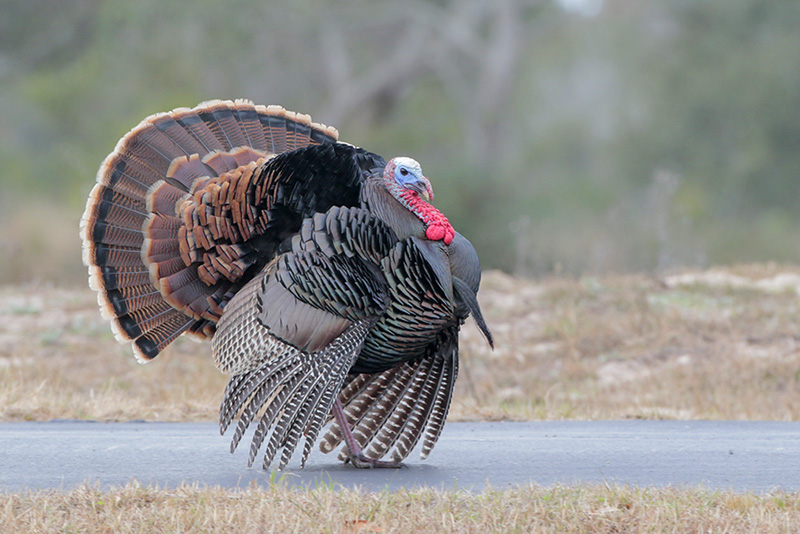Wild Turkeys (Meleagris gallopavo), native to North America, are adaptable birds found in various habitats from grasslands to open woodlands.
Males are larger with distinctive beards and colorful facial features, while females are smaller and either lack these characteristics or they are less pronounced. These gobblers are rather fascinating characters, so dive in!
On this page
Identification
Male
Male Wild Turkeys, also called toms, are generally larger and stockier than females, measuring 39-49 inches long and weighing 11-24 pounds. Their plumage is dark brownish overall with subtle shades of red, gold, bronze, copper, and green iridescence giving it a metallic sheen.
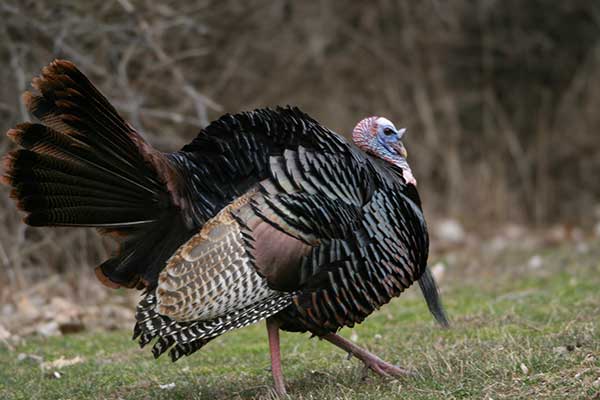
Males have a bare head and neck with skin tones varying from gray to blue to red. The fleshy outgrowth on their bill is called a snood and can change in length depending on their mood. They have carnucles on their neck and wattle on the underside of their neck, which changes color if they’re excited. Males also have a beard on their chest, which is a cluster of long, hair-like feathers.
Female
Female Wild Turkeys, also called hens, are noticeably smaller, measuring 30-37 inches long and weighing only 5.5-12 pounds.
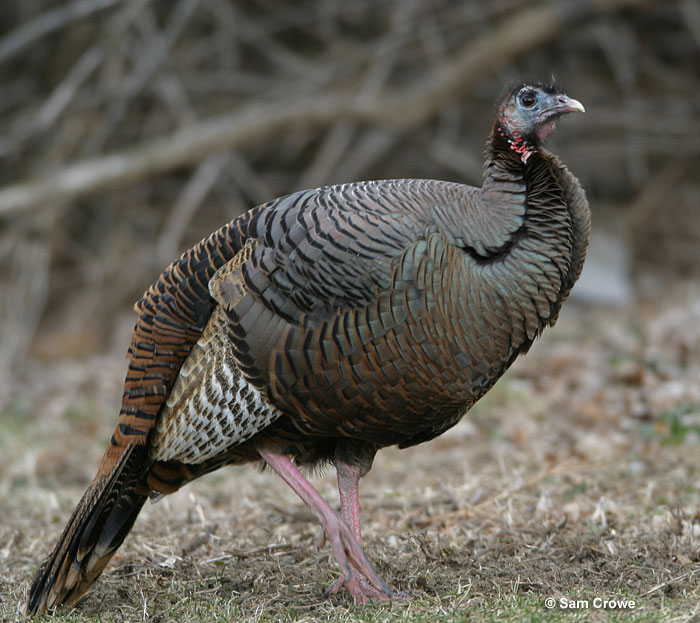
They also have a more subdued appearance with brown and gray tones and dark barring to provide better camouflage, especially during nesting.
Read more: Are female turkeys really that different?
Hens have a smaller and less prominent snood, and their facial features are less colorful and ornate compared to males. They generally don’t have a beard; only about 10% of them do.
Vocalizations
Wild Turkey’s most recognizable call is the male’s distinct gobble. They often do so from trees. It serves as both a mating display and a means to communicate with other males. This is not all, however.
Both toms and hens produce a variety of sounds such as clucks, purrs, cackles, and yelps. Juvenile Wild Turkeys whistle if they’ve lost their flock mates.
Food
Wild Turkeys are omnivorous with their diet being mostly plant-based, although there are some variations depending on the season and what’s available.
The plant part of their diet includes different grains, acorns, pecan, hickory, and beech nuts, seeds from sedges and grasses, leaves, grasses, roots, bulbs, buds, berries, such as wild black cherries, and ferns. During warmer seasons, especially the breeding season, they supplement their diet with various insects, snails, spiders, and the occasional frog, snake, salamander, or lizard.
Wild Turkeys forage in flocks, most commonly in the early morning or late evening, and on the ground. They scratch the ground and leaf litter to expose any hidden food items.
If they are going after berries, fruits, or buds, you may also see them climbing shrubs or trees to get to them. To help digest the food, they swallow grit.
Nesting and Eggs
In spring, males strut around, fanning out their tail feathers, puffing feathers, and dragging their wings on the ground. They also produce their distinct gobbling sound to attract the hens.
Males are polygamous and attempt to mate with multiple females and have no part in taking care of the offspring.
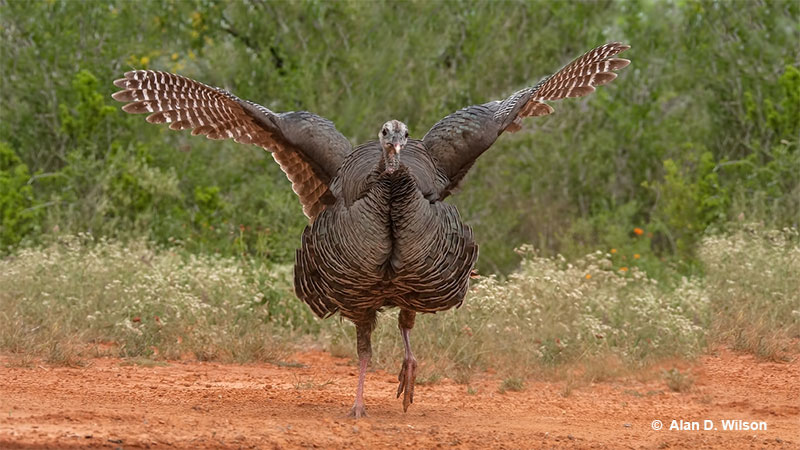
After mating, the female finds a suitable nesting site, which is usually on the ground in a relatively concealed place. That can be either in tall vegetation, under a shrub, or at the base of a tree. A Wild Turkey’s nest is just a scrape in the ground, lined with grass and dead leaves, which the female finds around the nest site.
They only have one brood in a year, which consists of 4-18, mostly 10-15 white to pale yellowish eggs that are dotted with pinkish or reddish brown spots. Wild Turkey’s eggs are 2-2.7 inches long and 1.6-1.9 inches wide. The female incubates the eggs alone for 25-31 days. She relies on her camouflaging colors and stillness to avoid detection.
The younglings leave the nest within 24 hours of hatching and the mother bird takes care of the young, leading them to food sources but leaving the foraging to the little ones.
For the first several weeks, the young have to be brooded by the mother at night. Chicks and mothers often combine their numbers and move around in groups. That’s why you can see flocks of young turkeys accompanied by two or more adult females running around.
The chicks grow quickly, and within a couple of weeks, they start learning to fly. The hen continues to care for and protect them until they become more independent. Juvenile Wild Turkeys are mostly dark brown.
Current Situation
Wild Turkeys range across the United States, most of Mexico, and some parts of southernmost Canada. They can be found in a variety of habitats, including fields, meadows, open forests and woodlands, shrublands, thickets, savannas, grasslands, and freshwater wetlands. However, their preferred habitats are hardwood and mixed forests with scattered openings.
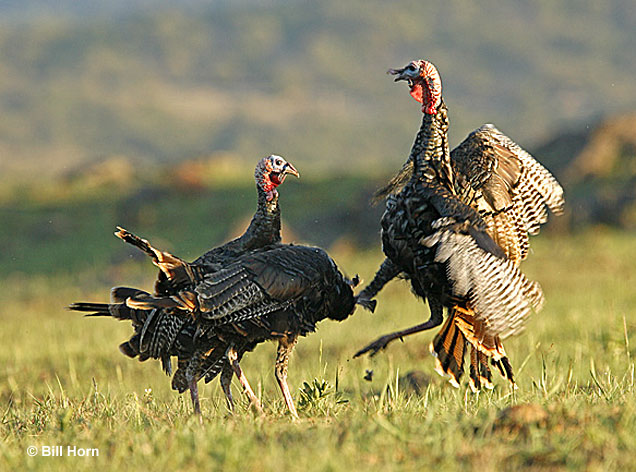
Wild Turkeys are listed as of least concern on the IUCN Red List. Their population is increasing, as is their range, even though they are one of the favorite game birds. They also face many threats such as snakes as rats in the egg and chick stage up to mountain lions, eagles, coyotes, and great horned owls as adults.
Facts
- The heaviest Wild Turkey on record weighed 37.1 pounds.
- Outside of the mating season, males and females form separate groups. They have separate hierarchies with the female one being more stable and the male one constantly changing.
- Wild Turkeys are generally ground-dwelling birds and don’t care much for flying or swimming. However, when the occasion calls for it, they can swim by spreading their tails, tucking their wings, and kicking.
- Domesticated turkeys can’t fly. However, Wild Turkeys can! They can reach speeds of up to 55 miles per hour, but only for a short time.
- You can tell whether it is a male or a female based on the shape of its droppings. Female Wild Turkey’s droppings are spiral-shaped whereas male’s end up looking like the letter J.
Similar Species
There are really no species that look highly similar to the male Wild Turkey, except for their domestic version. In the wild, pheasants and grouses look the most similar to female Wild Turkeys. Here are some examples and key differences.
Common Pheasant
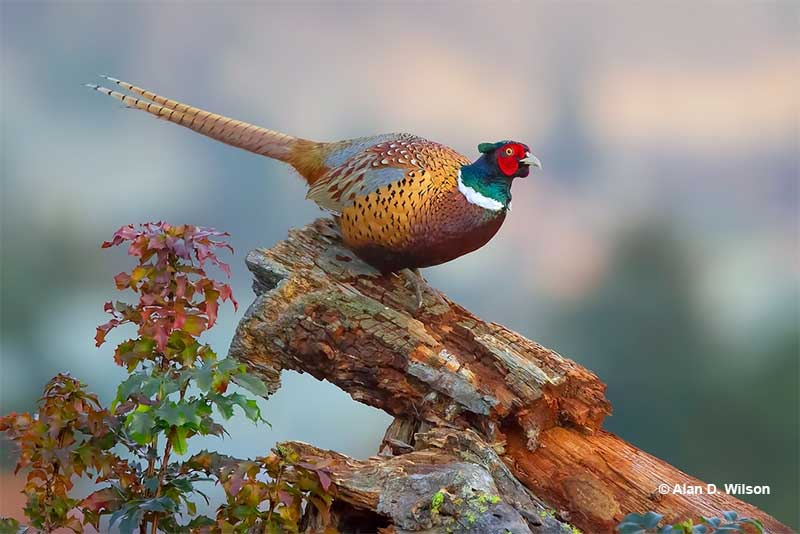
Common Pheasants have a smaller range than the Wild Turkeys and generally don’t end up in forests. The males are long-tailed with a body mottled in brown, tan, and gray, a greenish head, and a red face. Females are mottled in dark brown and tan.
Even though they are fairly large, then compared to the female Wild Turkey, the female Common Pheasants are smaller and less chubby. They also have a longer neck and tail and shorter legs, they’re lighter, and they have feathers on their head.
Sooty Grouse
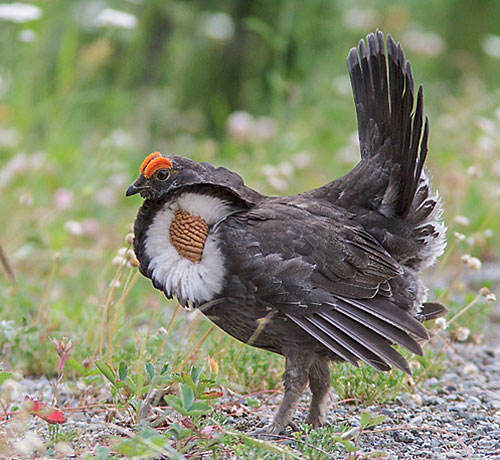
Photograph © Glenn Bartley
The Sooty Grouse has a rather limited range and can be found in the westernmost North America. They mostly inhabit mountainous areas with conifer forests. Male Sooty Grouse has dark, almost black plumage and they expose a bare yellow throat batch during the breeding season. Females are mottled brown with an overall dark appearance.
Compared to Wild Turkeys, Sooty Grouse has a chicken-like appearance. They’re smaller, have shorter legs and tails, and have a more upright posture. Females might look similar at a glance, but upon closer inspection, the female Wild Turkey is more uniformly dark and has a bare head and neck instead of a feathered one.
Frequently Asked Questions
How do you tell a male turkey from a female turkey?
Male Turkeys are noticeably larger with longer tail feathers, a beard protruding from their chest, and colorful and more pronounced facial features. Female Turkeys are smaller, less flashy, and generally don’t have a beard.
Do turkeys roost in the same tree every night?
Some Wild Turkeys may choose to roost in the same tree every night while others switch places.
What is the natural lifespan of a turkey?
The average lifespan for a Wild Turkey is three to four years.
Do turkeys mate for life?
Turkeys do not mate for life. Males are polygamous and mate with as many females as possible.
How long do baby turkeys stay with their mother?
Baby Wild Turkeys stay with their mother for around four to five months.
Can wild turkeys be friendly?
Wild Turkeys generally are not friendly, as they are wild animals (or birds in this case) and are cautious or even aggressive towards humans.
What to do if a wild turkey chases you?
If a Wild Turkey chases you, make yourself as big as possible and make lots of sound. If you have anything to swat at it, like a stick, then use it.

